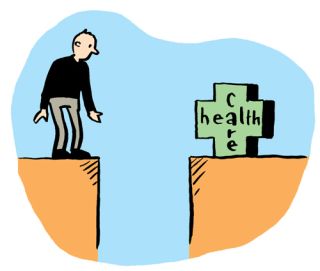Poverty, Health and Life-Expectancy

Health is not just about healthcare. The link between poverty and ill-health is well established by research. Poor people get sick more often and die younger than those in the higher socio-economic groups. Ireland faces significant challenges in this area. Inequalities in health in Ireland are closely linked with wider social determinants, including living and working conditions and access to services, trends which, taken together with an ageing population which must be addressed now to avoid significant problems in the future.
Health and life expectancy
International reports underline inequalities in life expectancy by socio-economic status, including education level, income or occupational group[1]. In older age, there are large disparities in the experience of disability by income level: on average across EU countries, about 18 per cent of people aged 65+ in the highest income quintile (top 20 per cent) report disability compared with 43 per cent among those in the lowest 20 per cent[2]. Internationally, poor people have had higher rates of COVID-19 infection and death, and income inequality itself also worsens outcomes[3].
A range of studies provide concerning evidence relative to inequality and health in Ireland. The OECD[4] suggests that a high proportion of Irish adults report being in good health, but differences occur across income groups: only 73 per cent of people in the lowest income quintile (lowest 20 per cent) assess their health as good, compared to 93 per cent in the highest (in 2017). Furthermore, Ireland was one of five OECD countries where people aged 65+ in the lowest income quintile (lowest 20 per cent) are more than twice as likely to report living in poor or fair health, compared with those in the highest income quintile[5]. At the other end of the lifespan, the Growing Up in Ireland study highlights a widening health and social gap by the time children are just 5 years old. Children from the highest social class (professional/managerial) are more likely than those from the lowest socio-economic group to be considered very healthy and have no problems[6].
The Irish Health Survey[7] suggests that the more disadvantaged a person is, not only is their self-reported health status poorer, but the more they engage with the health system. Thus, disadvantaged people report higher levels of having a long lasting condition – 29 per cent of Very disadvantaged persons compared to 22 per cent of Very affluent people. This survey also highlights the poorer health status of unemployed people who report higher levels of mental ill-health than people in employment.
Life expectancy is another area where differences exist between socio-economic groups in Ireland. Overall, life expectancy is continuing to increase, currently standing at 84 years for women and 81 years for men[8]. As in many countries, life expectancy is higher for women than men, but in Ireland this gap has narrowed in the past decade. These are positive developments. The COVID-19 pandemic resulted in unprecedented reductions in life expectancy in EU countries in 2020 and 2021[9]. Ireland was amongst the EU countries that had the smallest fall in life expectancy, at -0.2 years, which was well below the average reduction in life expectancy (of -1.2 years)[10]. However, official statistics from the Central Statistics Office suggest that life expectancy in Ireland differs based on socio-economic background[11]. For example, life expectancy at birth of males living in the most deprived areas was 79.4 in 2016/2017 compared with 84.4 for those living in the most affluent areas. The corresponding figures for females were 83.2 and 87.7 years, respectively.
Investing in our future health
All of this research and data tells us, in summary, poor people get sick more often and die younger than those in the higher socio-economic groups. The Department of Health acknowledges that Ireland faces significant challenges in this area and that inequalities in health are closely linked with wider social determinants, including living and working conditions and access to services, trends which, taken together with an ageing population, ‘if not addressed now, will lead to an unhealthy and costly future’[12]. Budget 2024 must invest €600m in the infrastructure rollout of Sláintecare with a focus on enhanced community care, and ensuring that the Regional Health Areas can service the health needs of the population of each area now, and as the population ages.
[1]https://www.oecd.org/health/health-for-everyone-3c8385d0-en.htm
[2]https://health.ec.europa.eu/system/files/2020-12/2020_healthatglance_rep_en_0.pdf
[3]https://www.who.int/publications/i/item/9789240038387
[4]https://www.oecd-ilibrary.org/social-issues-migration-health/health-at-a-glance-2019_4dd50c09-en
[5]https://www.oecd-ilibrary.org/social-issues-migration-health/health-at-a-glance-2019_4dd50c09-en
[6]https://www.esri.ie/publications/growing-up-in-ireland-well-being-play-and-diet-among-five-year-olds
[7]https://www.cso.ie/en/releasesandpublications/ep/p-ihsmr/irishhealthsurvey2019-mainresults
[8]https://www.gov.ie/en/publication/fdc2a-health-in-ireland-key-trends-2022/
[9]https://www.oecd.org/health/health-at-a-glance-europe/
[10]https://www.oecd.org/health/health-at-a-glance-europe/
[11]https://www.cso.ie/en/releasesandpublications/in/mdi/mortalitydifferentialsinireland2016-2017/#:~:text=Among%20those%20aged%2015%20years,See%20Table%204(b).
[12]https://www.gov.ie/en/publication/fdc2a-health-in-ireland-key-trends-2022/